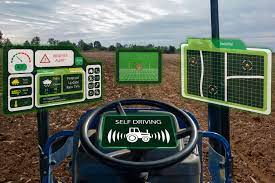In the age-old dance between man and land, technology has emerged as a new partner, revolutionizing the way we farm. From handheld devices to massive machines, advancements in technology are reshaping farm tools and equipment, driving efficiency, sustainability, and productivity to unprecedented levels. Let’s delve into the realms of this digital harvest and explore how technology is transforming farm tools and equipment.
Precision Agriculture: Cultivating Data-Driven Farming
Precision agriculture stands at the forefront of the technological revolution in farming. By leveraging data analytics, GPS technology, and remote sensing, farmers can now tailor their approaches to individual plants or even square meters of land.
1. Satellite Imagery and Remote Sensing: Satellites orbiting high above the Earth capture detailed images of farmland, enabling farmers to monitor crop health, detect pests or diseases, and optimize irrigation patterns.
2. GPS-guided Machinery: Tractors and other machinery equipped with GPS receivers can precisely navigate fields, ensuring accurate planting, fertilizing, and harvesting. This not only reduces overlap and waste but also minimizes soil compaction.
3. Drones for Crop Monitoring: Unmanned aerial vehicles (UAVs) equipped with specialized cameras can provide high-resolution aerial imagery of fields. Farmers use drones to monitor crop health, identify areas of concern, and assess the effectiveness of management practices.
Smart Sensors and Internet of Things (IoT)
The Internet of Things (IoT) is permeating every aspect of modern life, and farming is no exception. Smart sensors embedded in soil, machinery, and even livestock are generating vast amounts of real-time data, empowering farmers to make informed decisions on the fly.
1. Soil Moisture and Nutrient Sensors: These sensors measure moisture levels, temperature, and nutrient concentrations in the soil, allowing farmers to optimize irrigation and fertilization, leading to healthier crops and reduced water and nutrient waste.
2. Livestock Monitoring: Wearable devices equipped with sensors can track the health, location, and behavior of livestock. Farmers receive alerts for signs of distress or illness, enabling timely intervention and improved animal welfare.
3. Predictive Analytics: By analyzing data collected from various sensors and combining it with weather forecasts and historical trends, predictive analytics algorithms can anticipate crop yields, disease outbreaks, and optimal planting times, empowering farmers to make proactive decisions.
Robotics and Automation
Robotic technologies are gradually finding their place in the fields, automating labor-intensive tasks and enhancing efficiency while reducing the reliance on human labor.
1. Autonomous Tractors and Harvesters: Self-driving vehicles equipped with sensors and AI algorithms can plow fields, plant seeds, apply fertilizers, and harvest crops with precision and efficiency. These autonomous machines can work around the clock, maximizing productivity and minimizing operational costs.
2. Weeding Robots: Robots equipped with cameras and machine learning algorithms can distinguish between crops and weeds, precisely targeting and removing unwanted plants without the need for herbicides. This approach reduces chemical usage and promotes sustainable farming practices.
3. Drone Swarms for Crop Pollination: In response to declining bee populations, researchers are exploring the use of drone swarms equipped with pollen dispensers to pollinate crops. These drones can navigate fields autonomously, ensuring thorough pollination and safeguarding crop yields.
Challenges and Opportunities
While the transformation of farm tools and equipment through technology brings forth numerous benefits, it also presents challenges and considerations.
1. Cost and Accessibility: The initial investment in advanced technology can be prohibitive for small-scale farmers, limiting access to these innovations. Efforts to reduce costs and increase accessibility are crucial for ensuring equitable adoption across the agricultural sector.
2. Data Security and Privacy: With the proliferation of sensors and interconnected devices, ensuring the security and privacy of farm data becomes paramount. Robust cybersecurity measures and transparent data governance frameworks are essential to safeguarding sensitive information.
3. Digital Divide: Disparities in access to technology and digital literacy skills can exacerbate existing inequalities within the farming community. Bridging the digital divide through training programs and infrastructure development is essential for fostering inclusive technological adoption.
Conclusion
As we stand on the cusp of a new agricultural era, driven by innovation and technology, the future of farming looks promising. From precision agriculture and smart sensors to robotics and automation, the transformation of farm tools and equipment is revolutionizing the way we produce food, fiber, and fuel. Embracing these technological advancements presents an opportunity to enhance sustainability, increase productivity, and feed a growing global population while stewarding our precious natural resources for generations to come.





